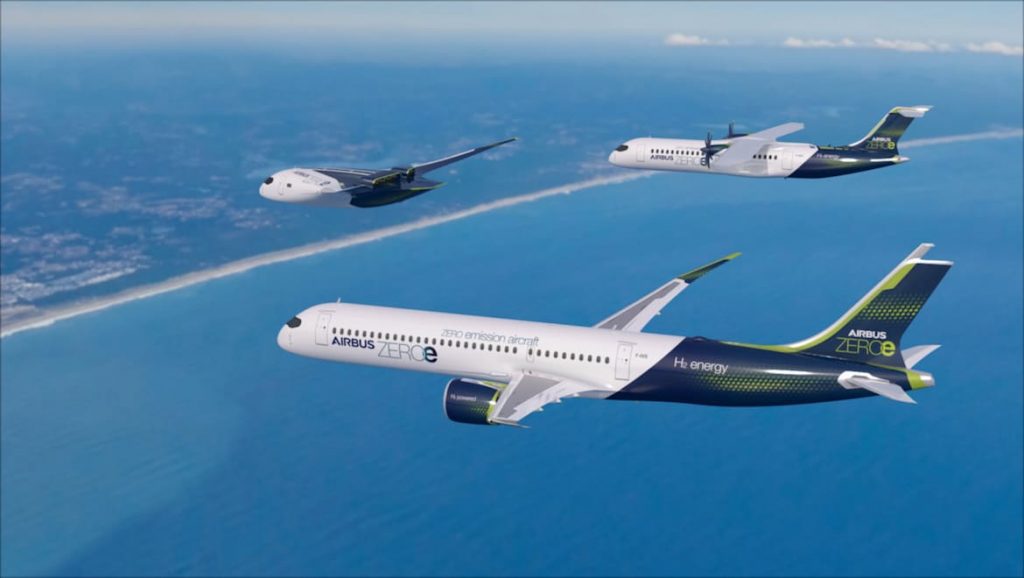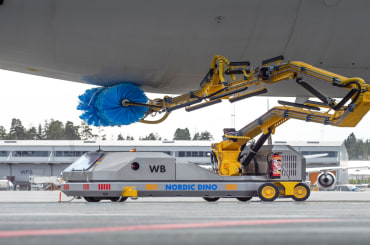
Airbus has announced it will accelerate its development of environmentally friendly aircraft by opening two centres to test and manufacture LH2 (liquid hydrogen) tank structures.
The ‘Zero-Emission Development Centres (ZEDC)’, located in Bremen, Germany, and Nantes, France, are set to be operational by 2023.
The move follows an earlier announcement, made in September 2020, that Airbus was working on the development of three new zero-emission hydrogen-powered aircraft, which it calls ‘ZEROe’, one of which it hopes to see enter service by 2035.
The planemaker set itself a goal to design and produce the world’s first carbon-free commercial aircraft by 2035, as European governments continue to push for the use of cleaner technology.
Airbus’ ‘ZEROe’ aircraft instead utilise liquid hydrogen, which the planemaker notes as the most promising future aviation fuel source.
The three aircraft were designed differently to test which would be most efficient and economically viable, according to Airbus.
The planemaker has said it has slotted to begin flight testing of its hydrogen fuel tanks as soon as 2025, two years after its ZEDCs open.
“The technology developments will cover the full product and industrial capabilities from elementary parts, assembly, systems integration and the cryogenic testing of the final liquid hydrogen (LH2) tank system,” Airbus said in a statement announcing the move.
The decision to set up a ZEDC at its home ground in Nantes due to its “extensive knowledge in metallic structural technologies related to the centre win box, including the safety-critical centre tank for commercial aircraft”, according to Airbus.
Airbus’ central wing boxes, centre line beams, nose cones and nacelle air intakes are already manufactured in Nantes.
Meanwhile, Bremen was chosen to house the second centre due to its diverse set up of LH2 experience. The ZEDC will focus on system installation, including the overall cryogenic testing of the tanks, according to the statement.
The tanks being built are safety-critical and require particular engineering systems. The storing of gas is a tedious operation, as its energy density is much larger than common jet fuel.
“LH2 is more challenging than kerosene because it needs to be stored at [minus 250 degrees] to liquefy. Liquidity is needed for increased density,” said the statement.
“For commercial aviation, the challenge is to develop a component which can withstand repeated thermal and pressure cycling which an aircraft application demands.”
Hydrogen fuel is a zero-carbon fuel burned with oxygen. When consumed in a fuel cell, it produces water. As an alternative to common jet fuel, many aviation and domestic vehicle companies are switching over to hydrogen-fuelled technologies to reach zero emission targets.
“A fuel cell coupled with an electric motor is two to three times more efficient than an internal combustion engine running on gasoline,” said the US Department of Energy.
Liquid hydrogen is notoriously volatile and requires extremely low temperatures. Some worry common usage onboard aircraft is not safe.
Amid its September 2020 announcement, Airbus dismissed such concerns, and instead called for massive investment in new energy infrastructure.
This is due to the fact that mist hydrogen used today is extracted from natural gas, which still creates carbon emissions.
Yet, the planemaker was adamant that any hydrogen used for aviation would instead be produced by means of renewable energy and extracted from water with electrolysis.
That process would in fact be carbon-free so long as it was powered from start to finish with renewable energy, however it is currently more expensive.
One such opponent of hydrogen-fuelled flight is Qatar Airways CEO Akbar Al Baker, who said hydrogen-based fuels are still not safe enough for public use.
Due to the volatility of the gas, he believes that over time more research will uncover an alternative biofuel that will be less combustible and keep passengers safe, in comparison with hydrogen fuel.












